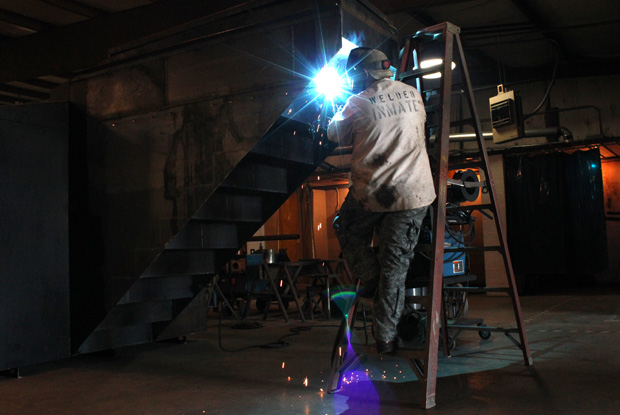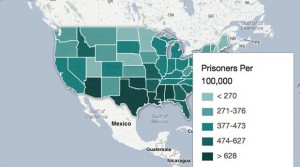
Caption
Joe Wertz / NPR StateImpact


Caption
Joe Wertz / NPR StateImpact

Joe Wertz / NPR StateImpact
An inmate practices for a career in welding by fabricating a tornado shelter at a Skills Center in the Howard McLeod Correctional Center near Atoka.
About 8,000 people are released from Oklahoma prisons each year, and employment improves an offender’s odds of not returning, criminologists and corrections officials say.
State prisons prepare inmates for the workforce through education and jobs skills training, which reduces recidivism and, ultimately, costs to taxpayers.
But after years of state budget cuts, prison classrooms have closed, teaching and instructor jobs have been eliminated, and fewer felons are receiving education and skills training.

Map: Joe Wertz / Source: U.S. Department of Justice
Click here to explore an interactive map of state incarceration.
Oklahoma is a national leader in putting people behind bars, and the state sits near the top of the list in every measure of state prisoners per capita.
One in 12 Oklahomans has a felony conviction on his or her record, according to the U.S. Department of Justice. State corrections officials say that number is probably a lot higher than that.
Looking at prison funding as a percentage of total state budget, Oklahoma is in the middle of the pack when compared to its six neighbors. Arkansas, Colorado and Missouri spent larger portions of their budgets on prisons in 2010, according to data from the National Association of State Budget Officers. But Oklahoma has more prisoners per capita than all its neighbors — and most of the country.
Oklahoma’s state budget started shrinking after fiscal year 2008, when the recession started settling in. The Department of Corrections’ total appropriation — including supplemental funding — has declined by about 8.5 percent since then, data show.
Appropriations to CareerTech, which runs the state prison Skills Centers — where inmates are given vocational and technology training — declined more than 15 percent from fiscal years 2009 to 2012.
The number of educators and instructors has declined, too, as has the number of offenders receiving education and training. Since 2008, the Department of Corrections has lost one-third of its full-time education staff; CareerTech has lost about the same percentage of Skills Center instructors.
Oklahoma had 15 prison Skills Centers in 2008. Five of those had been shuttered by 2011. The closed programs trained inmates for careers largely in trades like carpentry, masonry, plumbing, welding and electrical work.
The bulk of prison jobs training in Oklahoma is in the trades. Training is relatively short and inexpensive, and prisons — and taxpayers — benefit from prisoner labor while inmates are learning and practicing.
Inmates at the Howard McLeod Correctional Center near Atoka, for example, hone their machining skills by fabricating new parts to repair state-owned tractors and trailers. Inmates being trained to operate bulldozers and backhoes learn while trenching drainage ponds and doing maintenance at prisons and state-owned land.
Outside prisons, the trades are often hiring — and are often more likely to consider a job applicant with a felony record, says Department of Corrections director Justin Jones.
Finding any kind of employment reduces recidivism, but having a career-track job with decent prospects for pay and promotions is even more effective in helping felons stay out of prison, says Clint Castleberry, programs administrator for the state Department of Corrections.
“It can be a protective factor,” he says. “If you have a good-paying job, that’s something that potentially keeps you out of trouble and less at risk for recidivating.”

Joe Wertz / StateImpact Oklahoma
Inmate Sheila White is on work release from the Kate Barnard Community Corrections Center in Oklahoma City.
Oklahoma imprisons more women per capita than almost every other state in the country.
Two female-only work-release Skills Centers have closed in recent years, including a horticulture and landscape management program at the Governor’s Mansion, and a business and IT program out of the Altus Community Work Center.
And when it comes to jobs training, it’s often more important for recently released female felons to find gainful employment.
“Not only do they have to earn a living, in addition they have to figure out child care issues,” says Jim Meek, superintendent of the prison Skills Centers. “Many of them will jump out and take a low-paying job for survival, work long, hard hours and never gain on this because they can’t get enough earning capacity to really take care of their family the way they need to take care of them.”